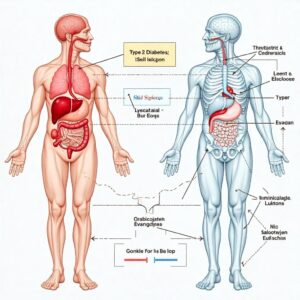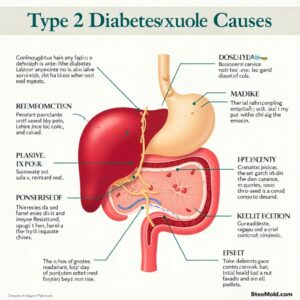Introduction
Type 2 Diabetes is a chronic, progressive condition that affects millions of people worldwide. Characterized by insulin resistance and high blood sugar levels, it can lead to severe health complications if not properly managed. With modern lifestyles contributing to its rising prevalence, understanding Type 2 Diabetes has never been more critical. This comprehensive guide explores the causes, symptoms, treatments, and prevention strategies for Type 2 Diabetes.

What is Type 2 Diabetes?
Type 2 Diabetes occurs when the body becomes resistant to insulin or when the pancreas fails to produce enough insulin. Insulin is essential to regulate the movement of sugar (glucose) into the body’s cells, where it is used for energy. Without effective insulin function, glucose builds up in the bloodstream, leading to high blood sugar levels.
Unlike Type 1 Diabetes, which is often diagnosed in childhood and is an autoimmune condition, Type 2 Diabetes is largely influenced by lifestyle factors and typically develops in adults, although it is increasingly being seen in children and adolescents.
Causes and Risk Factors
Several factors contribute to the development of Type 2 Diabetes:
1. Genetics
Family history plays a significant role. If you have a parent or sibling with Type 2 Diabetes, your risk is higher.
2. Obesity
Excess fat, particularly around the abdomen, increases the body’s resistance to insulin.
3. Physical Inactivity
Regular exercise helps maintain blood sugar control. Lack of physical activity can contribute directly to Type 2 Diabetes.
4. Age
The risk of Type 2 Diabetes increases as you age, especially after 45, although it is becoming more common in younger populations.
5. Ethnic Background
Certain ethnic groups, including African Americans, Hispanic Americans, Native Americans, and Asian Americans, are at higher risk.
6. Other Factors
- High blood pressure
- High cholesterol levels
- Polycystic ovary syndrome (PCOS)
- Gestational diabetes during pregnancy

Symptoms of Type 2 Diabetes
Many people with Type 2 Diabetes may not experience symptoms initially. However, as the condition progresses, common signs include:
- Frequent urination
- Increased thirst
- Unexplained weight loss
- Fatigue
- Blurred vision
- Slow-healing sores
- Frequent infections
- Areas of darkened skin (especially around the neck and armpits)
Recognizing these symptoms early can lead to a timely diagnosis and better management.
Diagnosis
Doctors use several tests to diagnose Type 2 Diabetes:
- Fasting Plasma Glucose Test: Measures blood sugar after an overnight fast.
- A1C Test: Provides an average blood sugar level over the past 2-3 months.
- Oral Glucose Tolerance Test: Measures blood sugar before and after drinking a sugary drink.
- Random Plasma Glucose Test: Measures blood sugar at any time, regardless of when you last ate.
Early diagnosis of Type 2 Diabetes is crucial to prevent complications.
Complications of Type 2 Diabetes
If left unmanaged, Type 2 Diabetes can cause serious health issues:
1. Cardiovascular Disease
People with Type 2 Diabetes are at higher risk for heart attacks, strokes, and atherosclerosis.
2. Kidney Damage (Nephropathy)
High blood sugar can damage the kidneys, potentially leading to kidney failure.
3. Eye Damage (Retinopathy)
Type 2 Diabetes can lead to blindness through damage to the retina.
4. Nerve Damage (Neuropathy)
High glucose levels can injure nerves throughout the body, causing pain, numbness, and digestive issues.
5. Foot Damage
Nerve damage and poor blood flow increase the risk of foot complications, sometimes leading to amputations.
Managing Type 2 Diabetes
While Type 2 Diabetes is a chronic condition, it can be effectively managed with lifestyle changes, medications, and regular monitoring.
1. Healthy Eating
A balanced diet is key. Focus on:
- Whole grains
- Vegetables and fruits
- Lean proteins
- Healthy fats
- Limiting sugar and refined carbs
2. Regular Exercise
Aim for at least 150 minutes per week of moderate aerobic activity, such as walking, swimming, or cycling.
3. Weight Management
Losing even a modest amount of weight can significantly improve blood sugar control.
4. Blood Sugar Monitoring
Regularly checking blood glucose levels helps track the effectiveness of treatment plans.
5. Medications
Several types of medications can help manage Type 2 Diabetes, including:
- Metformin (first-line treatment)
- Sulfonylureas
- DPP-4 inhibitors
- GLP-1 receptor agonists
- SGLT2 inhibitors
- Insulin therapy (in some cases)
6. Stress Management
Chronic stress can impact blood sugar levels. Techniques such as mindfulness, yoga, and deep breathing exercises can help.

Preventing Type 2 Diabetes
Prevention is possible, especially for those at high risk. Key strategies include:
1. Maintain a Healthy Weight
Losing 5-10% of body weight can significantly reduce the risk of Type 2 Diabetes.
2. Stay Active
Regular physical activity helps the body use insulin more efficiently.
3. Eat a Balanced Diet
Focus on fiber-rich foods and minimize processed foods.
4. Monitor Blood Sugar
If you are at high risk, regular screening can catch elevated blood sugar levels early.
Living Well with Type 2 Diabetes
A Type 2 Diabetes diagnosis is life-changing but manageable. Many people live full, active lives with the condition by following their treatment plan and making healthy lifestyle choices.
Building a Support Network
Involving family, friends, and healthcare professionals can provide encouragement and accountability.
Educating Yourself
Understanding Type 2 Diabetes empowers individuals to make informed decisions about their care.
Setting Realistic Goals
Small, achievable goals can lead to significant health improvements over time.
Future Outlook for Type 2 Diabetes
Research on Type 2 Diabetes continues to evolve. Advances in technology, such as continuous glucose monitors and artificial pancreas systems, are making management easier. New medications and potential cures are also being explored.
Preventative strategies, public health initiatives, and education are crucial to combat the growing global burden of Type 2 Diabetes.
Conclusion
Type 2 Diabetes is a significant global health challenge, but it is manageable and preventable. Understanding the causes, recognizing the symptoms, embracing a healthy lifestyle, and following medical advice can drastically improve quality of life for those affected.
Whether you are living with Type 2 Diabetes, at risk, or supporting a loved one, knowledge is your most powerful tool. Start today with small changes that lead to a healthier tomorrow.
Meta Description (SEO Optimized):
Learn everything about Type 2 Diabetes – causes, symptoms, complications, prevention, and effective management strategies. Discover how to live a healthy life with diabetes.


1 thought on “Type 2 Diabetes: Causes, Symptoms, Management, and Prevention”